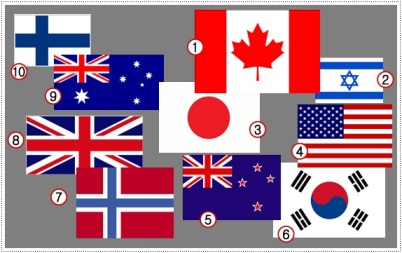College graduation rates continued to develop around the world throughout the recession, according to a recent international economic study. In more developed countries, the percentage of adults with equal of a college degree rose to more than 30 percent in 2010. In the United States, it was more than 40 percent that is among the highest percentages in the world.
These are the ten most educated countries all over the world.
1. Canada

Canada is the only nation where more than half of all adults had a tertiary education in 2010. This was up from 40 percent of the adult population in 2000, as the country also ranked as the world's most educated. Canada has managed to become a world leader in education without being a leader in education spending, that totaled just 6.1 %of GDP in 2009, or less than the 6.3 % average for the OECD. A large quantity of its spending went towards tertiary education, on which the country spent 2.5 % of GDP, trailing only the United States and South Korea. One of the few areas Canada did not execute well in was attracting international students, who made up very soon 6.6 % of all tertiary students that is lower than the OECD's 8 % average.
2. Israel
Israel only joined OECD in 2010. That year, its GDP per capita was more than $7,000 under the OECD's average. In spite of this, the country's high school graduation rate was 92 % in 2010, well above the OECD's 84 % average. Some 46 % of residents had a tertiary education, against 31% for the OECD. Israel spent 7.2 percent of GDP on educational institutions in 2009, sixth most among all nations. And for the first time, preschool education will become free in 2012 even for children as young as three years old. This has to benefit Israel as, according to the OECD, "early childhood education is associated with better performance later on in school."
3. Japan
In 2009, Japan spent 1.6 % of GDP on college or college equivalent education, as par with the OECD's average, and only 5.2 % of GDP on education overall, below the OECD's 6.3 % average. Even though it's relatively light spending, the country still had a high school graduation rate of 96 %, the second best among all nations in 2010, as the percentage of its population with a tertiary education was 14 percentage points higher than OECD's average.
4. United States
Although the U.S. is one of just a few nations where more than 40 % of people had a tertiary education in 2010, its education system is not without problems. Among the concerns, graduation rate for upper secondary students in 2010 was 77 %, well below the average rate of 84 % for OECD. Even though graduation rates were comparatively low, the U.S. is one of the biggest spenders on education, with related expenditures equalling 7.3 % of GDP in 2009. The U.S. was also the world's largest spender on tertiary education in 2009, at 2.6 % of GDP. The majority of funds for higher education, totalling 1.6 % of GDP, came from private sources.
5. New Zealand
The small country's population has grown 13.2 % between 2000 and 2010, as has the country's education system. The number of people with the college or college equivalent education rose from 29 % to 41 % over the time. The country also has become a destination of choice for international students, who pretended 14.2 % of tertiary students in 2010. New Zealand is also a leader in educating scientists; with 16 % of students choose a science for their field of study at the tertiary level as the highest proportion of any country.
6. South Korea
Between 2000 and 2010, percentage of South Koreans with a college education or more rose from 24 % to 40 %. In totalling to being well-educated, several residents also invested considerable amounts towards their schooling. In 2009, simply Iceland spent more than South Korea's 8 % of GDP. That year, no country in study contributed more private funds for education at all levels than South Korea, at 3.1 % of GDP, or for tertiary education, at 1.9 %. Even with the investment, education does not appear to have a measurable impact on job seekers. The unemployment rate in 2010 for those with the tertiary degree was 3.3 % low relative to the OECD average of 4.7 %, other than not much lower than the 3.7 % rate for all workers in the country.

7. United Kingdom
Between 2000 and 2010, percentage of U.K. residents with a tertiary education rose 12 percentage points. The country's universities are also popular among students from other nations. International students make up 16 % of enrolment. The country recently has had a shift in how education is financed. While in 2000 percentage of funds from private sources was 14.8 %, it rose to 31.1 % by 2009. Students also should cover more of the cost of higher education than in the past, as cap on tuition fees was raised from 3,290 pounds to 9,000 pounds for 2012-2013 year.
8. Finland
Finland spent 6.4 % of its gross domestic product on education in 2009, with 97.6 % of these funds coming from public sources, in excess of any country in the report. Between 2000 and 2010, high school graduation rates rose by only two percentage points, as the number of people with a college education or more rose by only six percentage points. Accordingly, Finland fell from fourth to eighth place among the world's most educated countries. Finnish workers with a tertiary education were far more possible to be employed than those without such an education as the unemployment rate was 4.4 % for residents with a degree and 8.4 % for those without.
9. Australia
Australia is a preferred purpose for various international students that are why it should come as no surprise that they accounted for 21.2 % of the country's tertiary students in 2010, advanced than every country other than Luxembourg. Finding a job in the country is not mainly hard for those with a college degree. The country had an unemployment rate of only 2.8 % in 2010 for workers with a tertiary degree, compared to a rate of just 5.2 % for all workers.
10. Ireland
From 2000 during 2010, percentage of people with a college education or more in Ireland nearly doubled, rising at an annual average of 7.3 % as faster than any country in study. High school graduation rates also rose throughout that time, from 74 % to 94 %. Education has become particularly critical for male job seekers in Ireland's workforce, as 6.3 % of men with a tertiary education were unemployed in 2010 versus 15.2 % for all men national.